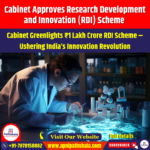GS Paper-I: Social Empowerment, population and associated issues, developmental issues, urbanization GS Paper-II: Governmental policies and interventions, Welfare schemes, important aspects of governance |
WHY IN NEWS?
Recently, different projects worth 5000 crores under AMRUT 2.0 have become part of the government’s 100-day agenda.
What is AMRUT?
It stands for Atal Mission for Rejuvenation and Urban Transformation Mission which comes under the Ministry of Housing and Urban Affairs (MoHUA).
It was launched on June 25, 2015, targeting 500 cities and towns across India.
Objective: The mission focuses on providing civic amenities like water supply, sewerage and septage management, stormwater drainage, green spaces and parks, and non-motorized urban transport to improve the quality of life for all especially the poor and the disadvantaged. The initiative also includes a set of urban reforms and capacity-building measures.
KEY FEATURES :
AMRUT is the modified form of the Jawaharlal Nehru National Urban Renewal Mission.
The aim of this mission is-
- To ensure that every household has access to a tap with supply of water.
- To have a sewerage connection.
- To increase the amenity value of cities by developing green and open parks.
- To reduce pollution by emancipating public transport like walking, and cycling.
AMRUT 2.0 :
AMRUT Mission has been subsumed under AMRUT 2.0, launched on October 1, 2021.
AMRUT 2.0, which spans from the financial year 2021-22 to 2025-26, aims to achieve universal water supply coverage by providing functional taps to all households in statutory towns, as well as ensuring sewerage and septage management in the initial 500 cities included in AMRUT.
AMRUT 2.0 will encourage a circular economy for water by developing City Water Balance Plans (CWBP) for each city, with an emphasis on recycling and reusing treated sewage, revitalizing water bodies, and conserving water resources.
This initiative will help cities identify projects aimed at universal water tap connections, water source conservation, rejuvenation of water bodies and wells, recycling/reusing treated wastewater, and rainwater harvesting. The mission aims to make cities ‘water secure’ through a circular water economy.
The reform agenda of AMRUT 2.0 includes improving citizens’ ease of living by reducing non-revenue water, recycling treated wastewater, rejuvenating water bodies, augmenting double-entry accounting systems, urban planning, and strengthening urban finance.
Other components of AMRUT 2.0 include:
- Pey Jal Survekshan to ensure equitable water distribution, wastewater reuse, water body mapping, and promoting healthy competition among cities/towns.
- Technology Sub-Mission for water to leverage the latest global technologies in water management.
- Information, Education, and Communication (IEC) campaign to spread awareness about water conservation.
WHAT HAS BEEN DONE SO FAR?
The Centre has approved sewerage and septage projects worth Rs 62,935.90 crore under the AMRUT 2.0 (Atal Mission for Rejuvenation and Urban Transformation) scheme. These projects include the establishment of a massive 29,105 km sewerage network and a sewage treatment capacity of 5,791.94 million litres per day (MLD).
The Ministry of Environment, Forest and Climate Change (MoEFCC) has established effluent standards for sewage treatment plants (STPs) based on four parameters: pH, Biochemical Oxygen Demand, Total Suspended Solids, and Fecal Coliform.
According to an order from the National Green Tribunal (NGT) and data on sewage from the report dated February 12, 2021, submitted by the Central Monitoring Committee led by the Secretary of Jal Shakti, Government of India, there are currently 30,001 MLD of sewage treatment plant (STP) capacity (1,261 plants) in urban settlements across 31 states and Union Territories. However, only 56 per cent of this capacity is being utilized for the treatment of municipal sewage.
IMPACT OF AMRUT 2.0 :
The impact of AMRUT 2.0 (Atal Mission for Rejuvenation and Urban Transformation) on the lives of people is multifaceted, addressing various aspects of urban living and enhancing overall quality of life. Here are some key effects:
Access to Clean Water: By providing universal access to functional taps in households, AMRUT 2.0 ensures that families have reliable access to safe drinking water. The provision of functional water taps in households ensures that women, who often bear the responsibility of fetching water, have easier and more reliable access to clean drinking water, saving them time and effort.
Improved Sanitation: Enhanced sewerage and septage management systems reduce the incidence of waterborne diseases, contributing to better public health and sanitation in urban areas.
Better Quality of Life: The development of green spaces, parks, and recreational areas promotes a healthier and more enjoyable living environment, enhancing residents’ overall well-being.
Health Benefits: With improved sanitation and water management, the prevalence of waterborne diseases decreases, leading to better overall health for women and their families, which is essential for their well-being and productivity.
Empowerment of women through Participation: AMRUT 2.0 emphasizes community involvement, allowing women to participate in decision-making processes regarding urban development. This engagement empowers them and gives them a voice in shaping their communities.
Reduction of Gender Disparities: Access to improved public services and infrastructure can help reduce gender disparities by providing women with equal opportunities for education, employment, and participation in civic life.
Environmental Sustainability: The promotion of water conservation practices, such as rainwater harvesting and recycling, helps residents become more environmentally conscious and responsible, contributing to a sustainable urban ecosystem.
CHALLENGES SO FAR :
- Despite the implementation of the scheme, approximately 200,000 people die each year due to insufficient water, sanitation, and hygiene.
- India’s disease burden from unsafe water and sanitation in 2016 was 40 times higher per capita than that of China, with minimal improvement observed.
- According to a NITI Aayog report, about 21 major cities are projected to deplete their groundwater resources, potentially leaving 40% of India’s population without access to drinking water by 2030.
- Additionally, nearly 31% of urban households in India lack piped water, while 67.3% are not connected to a piped sewerage system.
OTHER GOVERNMENT INITIATIVES :
- Smart Cities Mission (SCM): This is a Centrally Sponsored Scheme that was launched in June 2015 with the goal of transforming 100 cities by providing essential core infrastructure and a clean, sustainable environment to ensure a decent quality of life for residents through the implementation of “Smart Solutions.” The mission seeks to fulfil the aspirations of India’s urban population through a range of urban development projects.
- Pradhan Mantri Awas Yojana – Gramin: To accomplish the goal of “Housing for All” by 2022, the former rural housing initiative Indira Awaas Yojana (IAY) was revamped into the Pradhan Mantri Awaas Yojana-Gramin (PMAY-G) effective April 1, 2016.
To ensure that all rural families who are homeless or living in kutcha or deteriorating houses have access to a pucca house with basic amenities by the end of March 2022.
- Climate Smart Cities Assessment Framework: To create a clear roadmap for cities to address climate change as they plan and implement their actions, including investments.
- TULIP: The Urban Learning Internship Program: The program seeks to offer internship opportunities to 25,000 recent graduates in Urban Local Bodies (ULBs) and Smart Cities nationwide. TULIP was developed following the Budget 2020-21 announcement under the theme ‘Aspirational India,’ which emphasized shifting the educational approach from ‘doing by learning’ to ‘learning by doing.’
What challenges are encountered in implementing the AMRUT Scheme?
- State Project Implementation: Despite regular fund disbursements, states such as Bihar and Assam have not yet completed their projects or effectively utilized the PPP model, leading to an execution completion rate of less than 50% in most states.
- Unresolved Air Pollution: Although the National Clean Air Programme was launched to address the ongoing decline in air quality, AMRUT 2.0 has focused exclusively on water and sewerage, leaving air quality issues from AMRUT 1.0 unaddressed.Non-Inclusive Governance Structure: The mechanically designed scheme without organic participation from elected city governments, making it less inclusive scheme for urban people.
- Potential Overlaps and Convergence Challenges: The overlap between AMRUT and other initiatives, like the Swachh Bharat Mission, may create challenges in funding allocation and increase the workload in addressing specific urban issues.
- Non-Inclusive Governance Structure: The scheme’s mechanically designed framework lacks organic participation from elected city governments, making it less inclusive for urban residents.
- AMRUT Program Scope: The scheme adopts a project-centric approach rather than a comprehensive perspective.
WAY FORWARD :
- Improve Financial Mechanisms: Explore diversified funding sources, including public-private partnerships, to secure adequate financial resources for project execution.
- Holistic and People-centric approach: In light of climate change, shifting rainfall patterns, and current infrastructure, urban water management should address the evolving challenges. The scheme requires nature-based solutions and a comprehensive methodology that focuses on people and empowers local bodies.
- Emphasize Sustainability: Integrate environmentally sustainable practices in all aspects of the scheme, including water conservation, waste management, and green infrastructure.
- Incorporate Technology and Innovation: Leverage modern technologies and innovative practices in urban planning, water management, and infrastructure development to improve efficiency and sustainability.
- Conduct a Comprehensive Assessment: Evaluate the existing progress and challenges faced by the AMRUT scheme in various cities to identify areas needing improvement.
Regular Review and Adaptation: Set up a mechanism for periodic review of the scheme’s objectives and strategies to adapt to changing urban dynamics and challenges.
Explore our courses: https://apnipathshala.com/courses/
Explore Our test Series: https://tests.apnipathshala.com/










